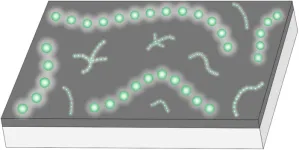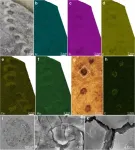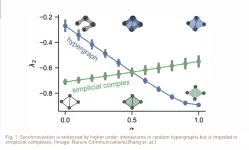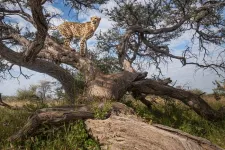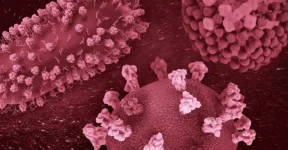(Press-News.org) Horodyskia, characterized by a string of beads with uniform size and spacing, is a kind of macroscopic fossil with a record extending from the early Mesoproterozoic Era (~1.48 Ga) to the terminal Ediacaran Period (~550 Ma).
Now, researchers led by Dr. LI Guangjin and Prof. PANG Ke from the Nanjing Institute of Geology and Palaeontology of the Chinese Academy of Sciences (NIGPAS) and Prof. CHEN Lei from Shandong University of Science and Technology have revealed that Horodyskia is among the oldest multicellular macroorganisms and may have attained its macroscopic size through a combination of coenocytism and simple clonal coloniality.
The study was published in Communications Biology on April 12.
Proterozoic macroscopic fossils are crucial for understanding the early evolution of eukaryotes, particularly how and when early eukaryotes developed complex multicellular grades of organization and acquired body sizes that are visible to the naked eye.
One of the prominent features of Horodyskia in previously reported specimens is the cast-and-mold preservation in fine-grained siliciclastic rocks or in cherts (silicification), with no evidence for the preservation of organic walls. This feature further impedes the biological and phylogenetic interpretation of Horodyskia.
The new Horodyskia specimens in this study, from the Tonian Shiwangzhuang Formation (~850–720 Ma) in western Shandong and the Jiuliqiao Formation (~950–720 Ma) in North China's Huainan region, are unique in their diverse preservational styles, including carbonaceous compressions, three-dimensionally preserved organic-walled fossils, shallow impressions, and casts and molds.
The carbonaceous nature of Horodyskia fossils, similar to representative carbonaceous compression macrofossils from the Shiwangzhuang Formation, suggests an underlying biological origin. Importantly, the carbonaceous compression specimens and three-dimensionally preserved organic-walled specimens are similar in morphology and size, strongly disputing the possibility of sedimentary structures, mud flocs, or intraclasts.
Raman spectroscopy reveals that the carbonaceous material of the Shiwangzhuang Horodyskia specimens have spectral characteristics similar to coexisting multicellular fossils, indicating that they both experienced low-grade metamorphism with similar peak metamorphic temperatures. Given the presence of possible compressional folds and three-dimensional preservation, the Shiwangzhuang and Jiuliqiao specimens suggest that Horodyskia beads are bona fide fossils with organic-walled vesicles.
Two groups of fossils with distinct bead sizes were observed on the same bedding plane in the Shiwangzhuang Formation. They have the same preservational style, exhibit similar positive correlations between bead diameter and spacing and between bead diameter and distance, and share a largely overlapping chemospace distribution, suggesting that they are not only biogenic, but also likely congeneric organisms. The ranges of their bead diameters overlap with that of Horodyskia minor from the Liuchapo Formation and that of H. moniliformis from the Appekunny Formation, respectively, supporting the assignment of specimens with submillimetric beads to the genus Horodyskia. These findings suggest that Horodyskia has a stratigraphic range from the early Mesoproterozoic to the late Ediacaran, with remarkable long-term morphological stability over 900 Myr.
Overall, Horodyskia can be reconstructed as a chain-like organism or a colony of individuals composed of several to dozens of vesicles or cells with a recalcitrant organic wall and likely embedded in an amorphous gelatinous matrix. The observed division in beads and paired beads likely resulted from binary fission and indicate that the submillimetric to millimetric beads of Horodyskia very likely represent giant cells. Horodyskia cells are orders of magnitude larger than typical prokaryotic cells, and their inferred large-sized recalcitrant cell walls are unusual for prokaryotic cells. Therefore, Horodyskia is unlikely to be a prokaryotic organism.
"The large cell size of Horodyskia indicates that it is not only a eukaryote, but also likely a multinucleated or coenocytic eukaryote," said Prof. PANG. "The submillimeter- to millimeter-sized cells of Horodyskia seem to require multiple nuclei to regulate the giant mass of cytoplasm."
The cellular nature and the unconnected, but occasionally dividing, feature of Horodyskia beads, indicate that these fossils are unlikely to be complex multicellular organisms, but are more likely to be protists whose clonal cells formed simple and not fully integrated colonies (i.e., simple clonal coloniality). Protists with simple clonal coloniality construction, a submillimetric to millimetric cell size (or inferred coenocyte), and a recalcitrant cell wall—features that define Horodyskia—are limited to a smaller number of eukaryotic clades. This study evaluated the three most likely potential analogs: arcellinid testate amoebae, foraminifers, and some algal groups, all of which have been proposed in previous studies.
The most plausible phylogenetic interpretation for Horodyskia is that it represents a multicellular, giant-celled protist, which has acquired a large body size and shares some similarities with living coenocytic algae and monothalamid foraminifers, although the latter are typically unicellular and therefore less comparable. Together with other possible early-middle Proterozoic coenocytic fossils, Horodyskia provides an important temporal constraint on the origin of coenocytic eukaryotes.
END
Horodyskia is among the oldest multicellular macroorganisms: Study
2023-04-21
ELSE PRESS RELEASES FROM THIS DATE:
Study: Do higher-order interactions promote synchronization?
2023-04-20
APRIL 20, 2023
Researchers use networks to model the dynamics of coupled systems ranging from food webs to neurological processes. Those models originally focused on pairwise interactions, or behaviors that emerge from interactions between two entities. But in the last few years, network theorists have been asking, what about phenomena that involve three or more? In medicine, antibiotic combinations may fight a bacterial infection differently than they would on their own. In ecology, survival strategies may arise from ...
Synthetic biology meets fashion in engineered silk
2023-04-20
Scientists have long been intrigued by the remarkable properties of spider silk, which is stronger than steel yet incredibly lightweight and flexible. Now, Fuzhong Zhang, a professor of energy, environmental and chemical engineering at the McKelvey School of Engineering at Washington University in St. Louis, has made a significant breakthrough in the fabrication of synthetic spider silk, paving the way for a new era of sustainable clothing production.
Since engineering recombinant spider silk in 2018 using bacteria, Zhang has been working to increase the yield of silk threads produced from microbes while maintaining its desirable properties of enhanced ...
Study reveals a novel biomarker and a potentially improved therapy for Multiple Sclerosis and related neurodegenerative disorders
2023-04-20
Houston, TX – Degeneration of myelin, an insulating sheath required for rapid communication between nerve cells, and neuroinflammation are notable hallmarks of Multiple Sclerosis (MS) and related neurodegenerative disorders such as Alzheimer’s disease or Huntington’s disease that affect roughly 2.8 million people in the world. However, little is known about the precise molecular steps by which demyelination leads to the loss of neurons and glia, the two major types of brain cells.
A paper published recently in Cell Metabolism by a research team led by Drs. Hugo J. Bellen, Hyunglok Chung, and Hyun ...
Dr. Elizabeth Whitlock to be honored at #AGS23 for her cross-cutting work in geriatrics, anesthesiology, and epidemiology
2023-04-20
New York, NY (April 20, 2023) — The American Geriatrics Society (AGS) and the AGS Health in Aging Foundation today announced that Elizabeth L. Whitlock, MD, an Assistant Professor in the Department of Anesthesia and Perioperative Care at the University of California, San Francisco (UCSF) is the 2023 recipient of the Jeffrey H. Silverstein Memorial Award for Emerging Investigators in the Surgical and Related Medical Specialties.
The award will be presented at the 2023 AGS Annual Scientific Meeting (#AGS23) which is being held in Long Beach, CA from May 4-6 (preconference day is May 3). The award recognizes Dr. ...
Extraction influences seismicity at some hydraulic fracturing sites in Ohio
2023-04-20
A decade’s worth of research at oil and gas operations in the central and eastern United States has confirmed that fluid injection from hydraulic fracturing and wastewater disposal can induce seismicity.
Now, data from hydraulic fracturing wells in eastern Ohio indicate that extraction activities also can influence the seismicity rate, according to a presentation at the Seismological Society of America (SSA)’s 2023 Annual Meeting.
During hydraulic fracturing, well operators inject a pressurized liquid ...
Cheetahs need more space: Reintroduction in India must consider their spatial ecology
2023-04-20
In autumn 2022 and winter 2023, a total of 20 cheetahs from Namibia and South Africa were introduced to Kuno National Park in India to establish a free-ranging population – for the first time since their extinction in India 70 years ago. Although the idea may be commendable, getting it right is not so easy. Scientists of the Cheetah Research Project of Leibniz-IZW in Namibia see shortcomings in the reintroduction plan: In southern Africa, cheetahs live in a stable socio-spatial system with widely spread territories and densities ...
From pathogens to fads: Interacting contagions
2023-04-20
APRIL 20, 2023
Most people think of a disease outbreak when they hear the word “contagion.” But it’s a concept that extends beyond pathogens. It could be an infectious disease, a fad, an online meme, or even a positive behavior in a population.
“From the mathematical perspective, a contagion is just a thing that spreads,” says Laurent Hébert-Dufresne, a former SFI Postdoctoral Fellow, now an associate professor in computer science at the University of Vermont.
April 19–21, Hébert-Dufresne and Juniper Lovato, ...
Beaver ponds with deeper sediments store more nitrogen, simple mapping reveals
2023-04-20
American Geophysical Union
20 April 2023
AGU Release No. 23-18
For Immediate Release
This press release and accompanying multimedia are available online at:
https://news.agu.org/press-release/beaver-ponds-with-more-sediments-store-more-nitrogen-simple-mapping-reveals/
Beaver ponds with deeper sediments store more nitrogen, simple mapping reveals
Simple mapping of beaver ponds can help land managers and conservationists in the West detect which ponds are sponging up nitrogen and which are releasing it
AGU press contact:
Rebecca Dzombak, +1 (202) 777-7492, news@agu.org (UTC-4 hours)
Contact information for the researchers:
Desneiges ...
New drug may help prevent migraine for difficult cases
2023-04-20
EMBARGOED FOR RELEASE UNTIL 4 P.M. ET, THURSDAY, APRIL 20, 2023
MINNEAPOLIS – The drug atogepant may help prevent migraines for people who have had no success with other preventive drugs, according to a preliminary study released April 20, 2023, which will be presented at the American Academy of Neurology’s 75th Annual Meeting being held in person in Boston and live online from April 22-27, 2023. The study involved people with episodic migraine, which is defined as having up to 14 headache days per month with migraine ...
ChatGPT is still no match for humans when it comes to accounting
2023-04-20
Last month, OpenAI launched its newest AI chatbot product, GPT-4. According to the folks at OpenAI, the bot, which uses machine learning to generate natural language text, passed the bar exam with a score in the 90th percentile, passed 13 of 15 AP exams and got a nearly perfect score on the GRE Verbal test.
Inquiring minds at BYU and 186 other universities wanted to know how OpenAI’s tech would fare on accounting exams. So, they put the original version, ChatGPT, to the test. The researchers ...
